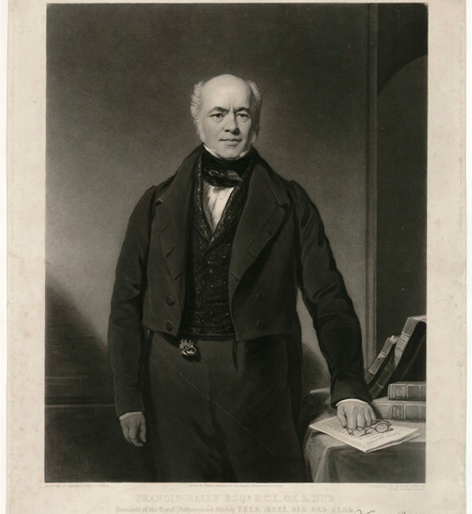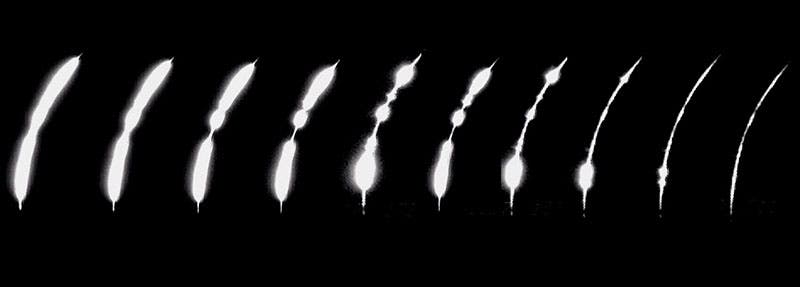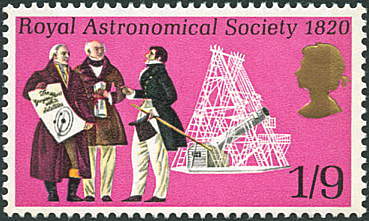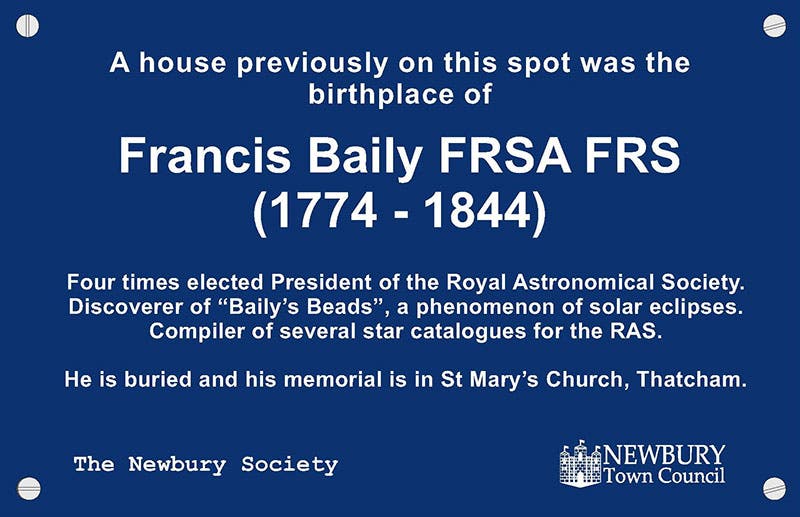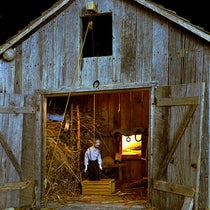Scientist of the Day - Francis Baily
Francis Baily, a British astronomer, was born Apr. 28, 1774. Although, as we shall see, Baily made some important contributions to observational astronomy, he was really at heart a historical astronomer. He wanted to know what the ancient astronomer Ptolemy was really looking at when he noted the position of the "star in the left shoulder of Bootes"; why John Flamsteed observed a star in Cassiopeia that no one else had seen since; and just how the star catalogs of Ulugh Beg and Tycho Brahe compared. His first historical study concentrated on just one man, Flamsteed, the first Astronomer Royal of England and the first man to compile a star catalog with the assistance of a telescope. Baily’s An account of the Revd. John Flamsteed,... to which is added, his British catalogue of stars, corrected and enlarged (1835) was a marvelous and meticulous study. Not only did he provide the first biography of Flamsteed, compiled from Flamsteed’s own diaries, and not only did Baily include a number of unknown letters from Flamsteed to his assistant, Abraham Sharp, revealing Flamsteed's bitterness at the treatment he had received from Isaac Newton, but Baily also provided a corrected and annotated version of Flamsteed's catalog of stars. Caroline Herschel, the sister of William Herschel, had spent much of her life trying to correct Flamsteed's star positions with reference to his observations, endeavoring to eliminate spurious stars and correct inaccurate star positions, and she did pretty well. But Baily really outdid her in every way. As one who wrote a paper once on Flamsteed’s unnoticed observation of the supernova Cassiopeia A, I became all too familiar with Baily's work, and I really appreciated how thorough he had been in correcting and compiling the definitive Flamsteed catalog
Having tidied up Flamsteed, Baily then proceeded to publish new editions of the star catalogs of five of the greatest stellar observers of all time, excluding Flamsteed: Ptolemy, Ulugh Beg, Tycho Brahe, Edmund Halley, and Johannes Hevelius. The Catalogues of Ptolemy, Ulugh Beigh, etc, was published in 1843, and it is indispensable to anyone who is trying to determine the positions or magnitudes of stars at different historical epochs. I found it just as vital as the Flamsteed catalog in trying to sort out the mess of who saw what, when and where. We have the first printed editions of all these catalogs in various rare books in our History of Science Collection, so we can check on Mr. Baily if we want to, but if he ever made a mistake, I never found it.
So, most of you are probably not very excited by any of this, and most likely I wouldn't be either, had I not wallowed in both books for more time than I care to remember. But Baily was also an active observer of all manner of astronomical phenomena, and on May 15, 1836, he happened to be observing a total eclipse of the Sun, when he noted that just before the moment of total eclipse, a string of very bright beads of light appeared on the limb of the Sun, before winking out. These have come to be known as "Baily's Beads," and the desire to observe them has motivated eclipse expeditions to all quarters of the globe, a quest that shows no sign of abating. The beads are caused by irregularities in the lunar surface, which cause the light of the Sun beyond to break down into separate spots of light as it pokes between the lunar mountains and craters. Above (second image) is a photo of a solar eclipse of 2016, observed in Indonesia, in which the beads are evident. We also include a montage of the final stages of another solar eclipse in 2010, during which the beads appear and disappear (third image, just above). Baily described his beads in a short report in vol. 4 of the Monthly Notices of the Royal Astronomical Society in 1836, which we have in the Library. I was going to have this notice scanned, but there are no images or figures, so I did not, and we look at more recent and more dramatic photographs instead.
Baily would be surprised to learn that he is remembered more for one observation of a moment's duration, than for the many years of labor it required to produce his annotated star catalogs. Baily was also one of the founders of the Royal Astronomical Society in London and was its President four times. He should be remembered for that as well. But he isn’t, and won't be. Fame is fickle that way. Baily was also far from the first to observe his beads; Edmond Halley, for one, commented on them over a century earlier. But Dame Fortune does not care. Baily’s beads are Baily’s beads, and that’s the end of it.
There is a fine engraved portrait of Baily at the National Portrait Gallery (first image), based on an original oil at the Royal Astronomical Society. There aren’t many other memorials. In 1970, a postage stamp was issued in Great Britain that commemorated the 150th anniversary of the founding of the Royal Astronomical Society in 1820, and there, between the two Herschels, father William at the left and son John at the right, stands Francis Baily (fourth image, above). And recently, the town of Newbury, in Berkshire, west of London, unveiled a blue plaque at the site of Baily’s former house (fifth image, just above). Baily was buried three miles away, at St. Mary’s church in Thatcham, but I could not find an image of his burial site or gravestone.
Dr. William B. Ashworth, Jr., Consultant for the History of Science, Linda Hall Library and Associate Professor emeritus, Department of History, University of Missouri-Kansas City. Comments or corrections are welcome; please direct to ashworthw@umkc.edu.

